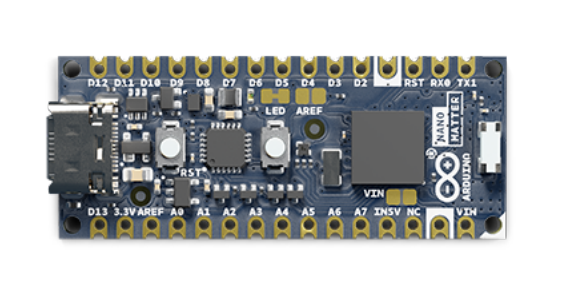Arduino’s Nano Matter board brings development of Matter-connected products to the masses with the easy-to-use ecosystem that has made Arduino a popular choice for many designers. As with the other modern Nano boards, the Nano Matter features a 4 g, 18 x 45-mm form factor and castellated pins for direct SMD soldering to an external carrier.
Other features that are not standard to the Nano product family include a USB-C port for data/programming and power supply, an RGB user LED, and a user button for immediate testing.
The Nano Matter has also been designed with ultra-low power consumption in mind to support battery-operated projects. The typical voltage supply is recommended at 5 V for a current draw of 16 mA when running the colour LED demo sketch, though power can be further reduced using techniques illustrated in the datasheet.
This board is built around Silicon Labs’ MGM240SD22VNA wireless microcontroller, which features a 32-bit Cortex-M33 core running at up to 78 MHz and offers 802.15.4 Thread, Bluetooth Low Energy 5.3, and Bluetooth Mesh connectivity in addition to supporting the Matter protocol – an antenna is included on the board to enable immediate use of these connectivity features.
This wireless connectivity is also protected by Silicon Labs’ Secure Vault technology to keep your IoT safe from external attacks.
The internal memory of the Nano Matter board includes 1536 kB of flash and 256 kB of RAM, and the pinout is illustrated below:

As you can see, the standard power LED is included as well as the following interfaces:
- 22x GPIOs with PWM
- 8x 12-bit ADCs
- 2x 12-bit DACs
- 1x I2C interface
- 1x UART interface
- 1x SPI interface
- 2x GND pins
- 1x 3V3 out for reference and powering peripherals
- 1x reset button and 1x reset pin
The Nano Matter enables you to further reduce the power consumption of the design by cutting the jumper for the power indicator LED. A JTAG/SWD debug port is also accessible through the boards test pads if required during development; debugging can also be done over USB.
As a wirelessly connected board, the Nano Matter is fully compatible with Arduino Cloud for remote monitoring, control, and data analysis. This also enables immediate testing of cloud-based platforms for applications including IoT, smart home, smart building automation, industrial automation, environmental monitoring, and climate control.
Further details about the Arduino Nano Matter can be found in this datasheet ahead of the full product release in May 2024. If you are interested in using this technology for Matter development in your next commercial project, fill out the form below, and ipXchange will get you connected with Arduino for early access and evaluation.


